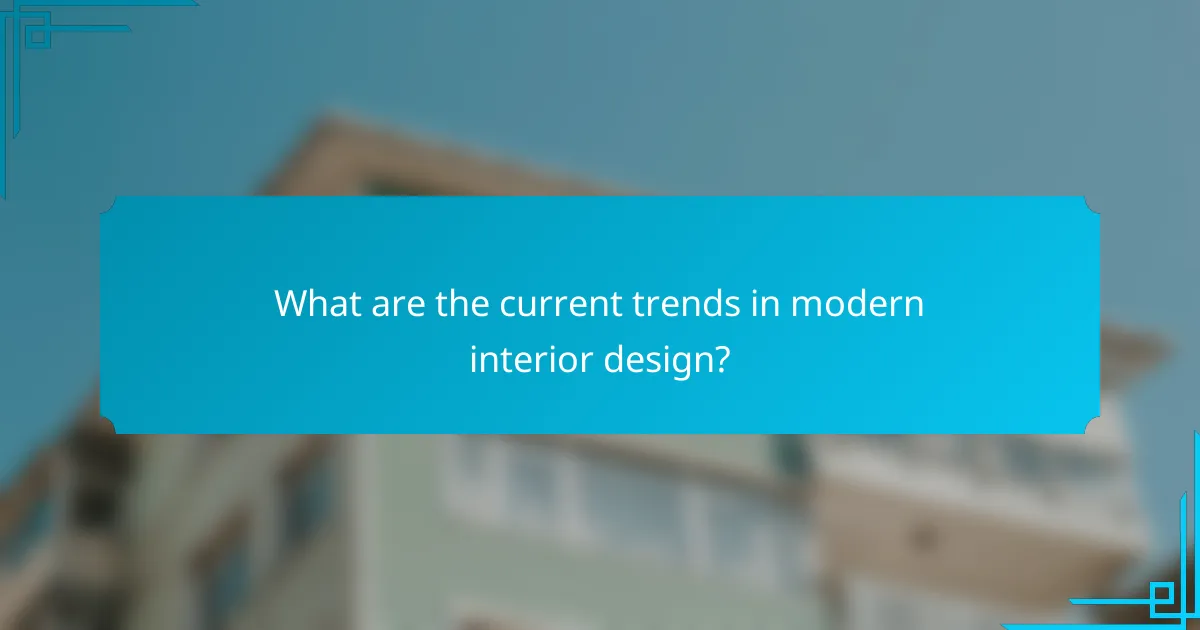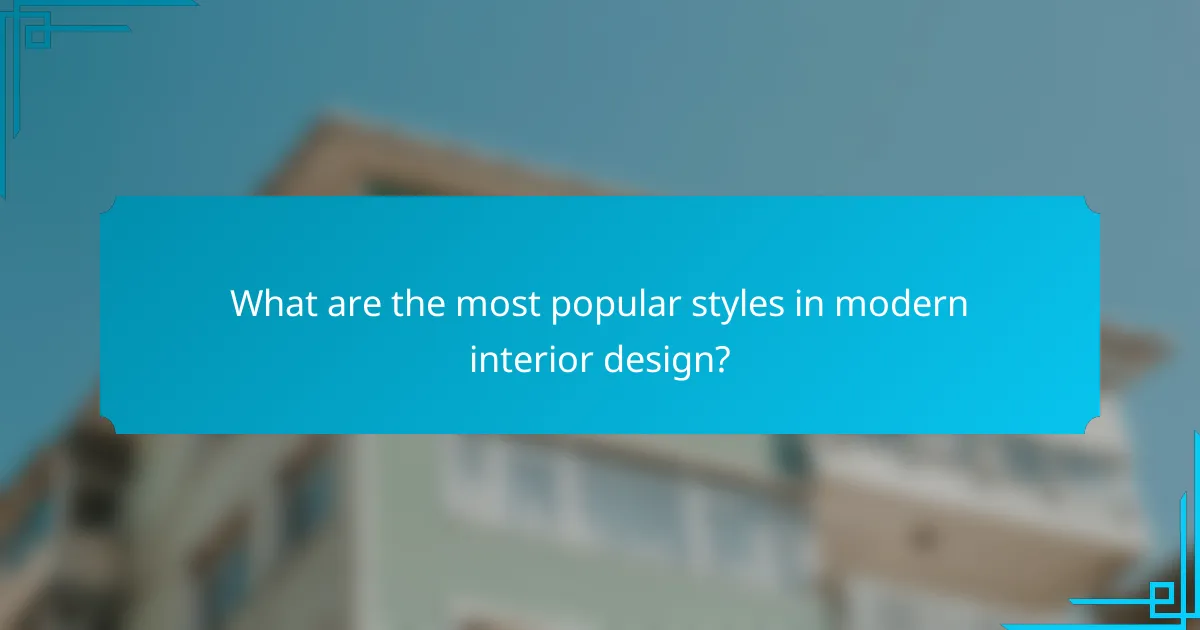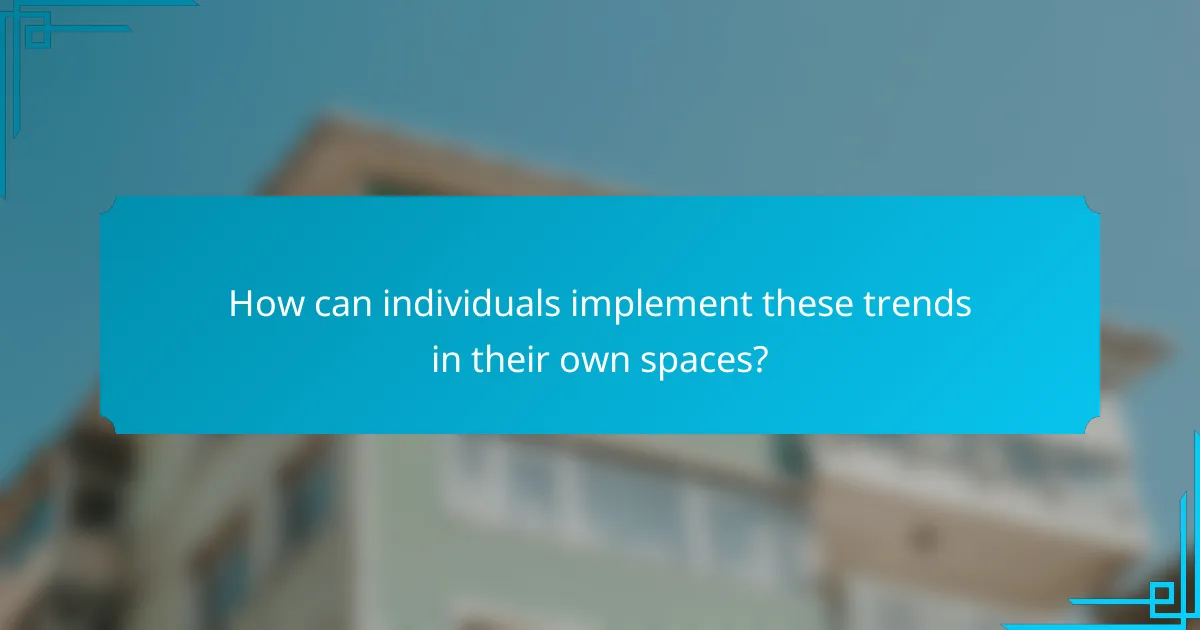The article explores current trends in modern interior design, focusing on key styles and practical applications. It highlights the significance of minimalism, sustainability, and multifunctional spaces, which prioritize simplicity, eco-friendliness, and versatility. Popular design styles such as industrial, Scandinavian, mid-century modern, and bohemian are examined for their distinct characteristics and aesthetic appeal. Practical implementation strategies include the use of multifunctional furniture, natural elements, neutral color palettes, effective lighting, and minimalist approaches to create serene and inviting environments. The integration of smart home technology and the resurgence of vintage styles further illustrate the evolving landscape of interior design.

What are the current trends in modern interior design?
Current trends in modern interior design include minimalism, sustainability, and multifunctional spaces. Minimalism focuses on simplicity and decluttering, promoting a clean aesthetic. Sustainability emphasizes eco-friendly materials and energy-efficient designs. Multifunctional spaces cater to versatile living, adapting to various needs. Biophilic design integrates natural elements, enhancing well-being. Bold colors and patterns are making a comeback, adding personality to spaces. Smart home technology is increasingly incorporated for convenience and efficiency. Lastly, vintage and retro styles are being blended with contemporary designs, creating unique, personalized environments.
How do these trends reflect a blend of style and practicality?
Modern interior design trends reflect a blend of style and practicality through functional aesthetics. These trends prioritize clean lines and minimalism, creating visually appealing spaces. They incorporate multifunctional furniture, maximizing utility without sacrificing design. For example, sofa beds serve both as seating and sleeping areas. Additionally, sustainable materials enhance both style and environmental responsibility. Trends also embrace open layouts, promoting spaciousness and ease of movement. This combination of elements demonstrates that modern design can be both beautiful and functional.
What are the key characteristics of stylish modern interiors?
Stylish modern interiors feature minimalism, clean lines, and functional spaces. They emphasize open floor plans that enhance flow and connectivity. Neutral color palettes dominate, often accented by bold hues or textures. Natural materials like wood and stone are commonly used to create warmth. Lighting plays a crucial role, with a focus on natural light and statement fixtures. Furniture is often sleek and multi-functional, catering to practical needs. Art and decor are curated to reflect personal style without overwhelming the space. Overall, stylish modern interiors balance aesthetics with functionality, appealing to contemporary lifestyles.
In what ways do practical elements enhance modern design?
Practical elements enhance modern design by improving functionality and user experience. They provide essential features that cater to the needs of everyday living. For example, multi-functional furniture maximizes space efficiency in smaller homes. Ergonomic designs promote comfort and well-being, which is crucial for long-term use. Sustainable materials contribute to environmental responsibility while maintaining aesthetic appeal. Additionally, practical elements can streamline maintenance, making spaces easier to care for. These enhancements lead to a harmonious balance between style and practicality in modern design.
Why is blending style with practicality important in interior design?
Blending style with practicality is crucial in interior design because it creates functional and aesthetically pleasing spaces. A well-designed interior must meet the needs of its users while also reflecting their personal style. Practicality ensures that the space is usable and comfortable, while style enhances the visual appeal. This balance leads to environments that promote well-being and productivity. Research indicates that well-designed spaces can improve mood and efficiency. For instance, a study by the University of Exeter found that good design can increase productivity by 15%. Therefore, blending style with practicality is essential for creating effective and enjoyable living or working environments.
How does this blend impact functionality and aesthetics?
This blend enhances both functionality and aesthetics in modern interior design. Functional elements ensure spaces are usable and practical. Aesthetic components contribute to visual appeal and emotional response. For example, open floor plans facilitate movement while creating a sense of spaciousness. Natural light enhances both functionality and beauty, improving mood and energy efficiency. The integration of multi-functional furniture maximizes space without sacrificing style. Textures and colors can evoke specific feelings, influencing how a space is perceived. Overall, this blend creates harmonious environments that are both beautiful and livable.
What are the psychological benefits of a well-designed space?
A well-designed space enhances psychological well-being. It promotes relaxation and reduces stress levels. Studies show that natural light improves mood and productivity. Aesthetic appeal can boost self-esteem and creativity. Organized spaces lead to improved focus and reduced anxiety. Elements like color and texture influence emotional responses. Biophilic design connects individuals to nature, enhancing mental health. Research indicates that well-designed environments can lead to higher satisfaction and overall happiness.

What are the most popular styles in modern interior design?
The most popular styles in modern interior design include minimalism, industrial, Scandinavian, mid-century modern, and bohemian. Minimalism emphasizes simplicity and functionality, often featuring neutral colors and uncluttered spaces. Industrial design incorporates raw materials like metal and wood, showcasing an urban aesthetic. Scandinavian style is known for its warmth and coziness, utilizing natural light and soft textures. Mid-century modern focuses on clean lines and organic forms, reflecting a retro vibe. Bohemian style embraces eclectic decor and vibrant colors, promoting a laid-back atmosphere. These styles reflect current trends that prioritize both aesthetics and practicality in living spaces.
How do different styles incorporate practical features?
Different styles incorporate practical features by integrating functionality into their design elements. For instance, minimalist style emphasizes clean lines and uncluttered spaces, promoting ease of maintenance. Scandinavian design incorporates natural materials, enhancing durability while providing warmth. Industrial style utilizes reclaimed materials, offering both aesthetic appeal and sustainability. Contemporary designs often feature multi-functional furniture, maximizing space efficiency. Each style balances visual appeal with usability, ensuring that spaces are both beautiful and practical. These approaches reflect a growing trend in interior design where aesthetics and functionality coexist harmoniously.
What defines minimalist interior design and its practicality?
Minimalist interior design is defined by simplicity, functionality, and a lack of clutter. It emphasizes clean lines, neutral color palettes, and essential furnishings. This design approach seeks to create spaces that feel open and airy. Practicality in minimalist design comes from its focus on multi-functional furniture and efficient use of space. For instance, a sofa bed serves as both seating and sleeping arrangements. The absence of excess items promotes easier maintenance and organization. Studies show that minimalist environments can reduce stress and enhance focus, supporting its practicality in modern living.
How does industrial design balance style and function?
Industrial design balances style and function by integrating aesthetic appeal with practical usability. Designers prioritize user experience while ensuring that products are visually engaging. This approach often involves using materials and forms that are both attractive and durable. For example, ergonomic shapes enhance comfort without sacrificing visual interest. Additionally, successful industrial design considers the manufacturing process to maintain efficiency. Research indicates that well-designed products can improve user satisfaction and increase marketability. A study by the Design Management Institute found that design-led companies outperform their competitors by 228% over ten years. This demonstrates the effectiveness of balancing style and function in industrial design.
What emerging styles are shaping modern interior design?
Emerging styles shaping modern interior design include biophilic design, minimalism, and maximalism. Biophilic design focuses on incorporating nature into spaces, enhancing well-being. This style uses natural materials, plants, and light to create a calming environment. Minimalism emphasizes simplicity and functionality, featuring clean lines and uncluttered spaces. It promotes a sense of peace through a limited color palette. Maximalism, in contrast, embraces bold colors and patterns, allowing for personal expression. This style encourages layering and eclectic decor choices. These trends reflect a shift towards creating spaces that are both aesthetically pleasing and practical.
How do sustainable materials influence new design trends?
Sustainable materials significantly influence new design trends by promoting eco-friendly practices. Designers increasingly prioritize materials that reduce environmental impact. This shift leads to the incorporation of recycled, reclaimed, and renewable resources. For instance, bamboo and reclaimed wood are popular for their sustainability and aesthetic appeal. The use of such materials often aligns with consumer demand for environmentally responsible products. Studies show that 70% of consumers prefer brands that demonstrate sustainability. Consequently, sustainable materials not only enhance design but also reflect changing consumer values.
What role does technology play in modern interior aesthetics?
Technology significantly influences modern interior aesthetics by enabling innovative design solutions. Smart home devices enhance functionality while maintaining visual appeal. For example, programmable lighting can create ambiance and mood. Virtual reality tools allow designers to visualize spaces before implementation. Advanced materials, such as eco-friendly composites, offer aesthetic versatility. Digital fabrication techniques enable customized furniture designs that fit unique spaces. Integration of technology also facilitates sustainable practices in interior design. Overall, technology merges practicality with style, shaping contemporary aesthetics in meaningful ways.

How can individuals implement these trends in their own spaces?
Individuals can implement trends in modern interior design by selecting multifunctional furniture. This type of furniture maximizes space and improves functionality. For example, a sofa bed can serve as both seating and sleeping space.
Incorporating natural elements is another trend. Adding plants can enhance air quality and create a calming atmosphere. Choosing materials like wood or stone can add warmth to the space.
Utilizing neutral color palettes is also effective. Neutral tones can make a room feel larger and more inviting. Accent colors can then be introduced through decor items.
Additionally, focusing on lighting is crucial. Layered lighting can create ambiance and highlight design features. Using energy-efficient bulbs can also reduce electricity costs.
Finally, embracing minimalism can help declutter spaces. Fewer items can lead to a more serene environment. This trend promotes the idea of “less is more,” enhancing both style and practicality.
What are some practical tips for blending style and functionality?
Choose a cohesive color palette. A unified color scheme enhances both aesthetic appeal and functionality. Incorporate multi-functional furniture. Pieces like sofa beds or storage ottomans save space while adding style. Use quality materials that are durable and visually appealing. High-quality fabrics and finishes improve longevity and design impact. Prioritize layout for both flow and aesthetics. An open and accessible layout enhances usability and visual harmony. Add decorative storage solutions. Stylish baskets or shelves can conceal clutter while enhancing decor. Layer lighting for ambiance and practicality. Combining ambient, task, and accent lighting creates a versatile atmosphere. Select statement pieces that serve a purpose. Artful yet functional items can elevate design while being useful.
How can color schemes enhance both style and practicality?
Color schemes enhance both style and practicality by creating visual harmony and influencing mood. A well-chosen color palette can make a space feel larger or cozier. For instance, light colors can brighten small rooms, enhancing their perceived size. Darker shades can add depth and richness to larger spaces, creating a sense of intimacy.
Additionally, color schemes can impact functionality. For example, using warm tones in kitchens can stimulate appetite and promote social interaction. Cool colors in bedrooms can create a calming atmosphere, promoting relaxation and better sleep.
Research indicates that color can affect productivity and focus. A study by the University of Texas found that specific colors can enhance cognitive performance. Thus, selecting appropriate color schemes can improve both aesthetic appeal and practical use of space.
What furniture choices optimize both aesthetics and usability?
Furniture choices that optimize both aesthetics and usability include multifunctional pieces, ergonomic designs, and minimalist styles. Multifunctional furniture, such as sofa beds or storage ottomans, serves dual purposes, saving space while enhancing decor. Ergonomic designs prioritize comfort and support, improving user experience in both home and office settings. Minimalist styles create a clean, uncluttered look that is visually appealing and promotes ease of movement. According to a study by the American Society of Interior Designers, these choices contribute to a more functional and beautiful living environment.
What common mistakes should be avoided in modern interior design?
Common mistakes in modern interior design include neglecting functionality, which can lead to impractical spaces. Overcrowding a room with furniture often disrupts flow and makes areas feel cramped. Ignoring scale and proportion can result in mismatched furniture sizes that clash visually. Using too many colors or patterns may create a chaotic atmosphere rather than a cohesive look. Failing to consider lighting can diminish the aesthetic and functionality of a space. Not incorporating personal style can lead to generic designs that lack character. Lastly, overlooking the importance of storage can result in cluttered environments that detract from overall design.
How can one ensure a cohesive design that remains practical?
To ensure a cohesive design that remains practical, one must focus on functionality and aesthetic harmony. This involves selecting a unified color palette that promotes visual consistency. Incorporating complementary materials enhances the overall look while ensuring durability. Additionally, maintaining a balance between form and function is essential. Each piece should serve a purpose without compromising style. Regularly assessing the layout for efficiency can improve usability. According to the National Kitchen and Bath Association, kitchen design should prioritize workflow, which exemplifies practical design. By integrating these principles, designers can achieve a visually appealing and functional space.
What are the pitfalls of prioritizing style over functionality?
Prioritizing style over functionality can lead to several pitfalls. One major issue is reduced usability. Spaces may look appealing but become impractical for daily activities. This can frustrate users who find it hard to navigate or use the space effectively.
Another pitfall is increased maintenance. Stylish materials may require more upkeep, leading to higher costs over time. For example, intricate designs often collect dust and dirt more easily.
Additionally, prioritizing aesthetics can result in poor space planning. A visually striking room may lack essential storage or seating, diminishing its overall effectiveness.
Finally, this approach can alienate potential buyers or renters. Many people prioritize functionality when selecting a home or office space. Therefore, overly stylized interiors may deter interest in the market.
What are the best practices for creating a stylish yet practical interior?
Use a cohesive color palette to create a stylish yet practical interior. A unified color scheme enhances visual flow and makes spaces feel larger. Incorporate multifunctional furniture to maximize utility. Pieces like sofa beds or storage ottomans serve dual purposes. Prioritize quality materials for durability and aesthetic appeal. High-quality fabrics and finishes withstand wear while looking elegant. Utilize smart storage solutions to reduce clutter. Built-in shelves and hidden compartments maintain organization without sacrificing style. Layer lighting to create ambiance and functionality. Combining ambient, task, and accent lighting enhances both practicality and design. Personalize the space with decor that reflects your style. Unique artwork or accessories add character while remaining functional.
Trends in modern interior design focus on blending style with practicality, highlighting minimalism, sustainability, and multifunctional spaces. Key characteristics include clean lines, neutral color palettes, and the incorporation of natural materials to create aesthetically pleasing yet functional environments. This article explores how various design styles, such as industrial and Scandinavian, integrate practical features, and emphasizes the importance of psychological benefits derived from well-designed spaces. Additionally, it provides practical tips for implementing these trends, ensuring a cohesive design that enhances usability while reflecting personal style.